Motorsports Racing News & Blog Articles
Church of MO: 2002 Honda 919 First Ride
Here at modern MO, we probably wouldn’t publish a road test of a new Honda without a few photos of the thing in action. Twenty years ago, though, there was probably a perfectly reasonable-sounding excuse: My dog ate the film, a bear ate the photographer… Most probably, somebody slud the shiny new Honda 919 down the road on the way to the shoot, and the show had to go on. Who knows? They shouldn’t have called the color “Asphalt.” In any case, this CBR900RR-based naked has become something of a cult classic, well loved by people who love Hondas. Enjoy the tiny studio photos and full spec chart.
An old wolf in sheep’s clothes.
Torrance, California, – We, as a people, must be getting soft. Maybe its the years of feel-good politics that have done it to us, or maybe its the antibiotics in our milk. Whatever the case, there are more people than ever who just can’t bear the thought of riding a narrow-focus sportbike. “Too uncomfortable,” they’ll say. “Too peaky,” opine others. “Too complicated,” say yet another group of malcontents, fed up with the current crop of superbike replicas. Still, insists Honda, these folks are a far cry from trading in their daily adrenaline fix for a bottle of Geritol. For these people, it’s Honda’s 919 that seems to be tailor made. In fact, the bike may even appeal to some crossovers who want a bike that should be almost as quick as any pure sportbike on a back road, carrying out said duty with the sort of street-fighter flare and old-school charm only a bike like the 919 can possess.After all, its motor is based on the same powerplant that once made the CBR900RR such a popular track machine in 1993.
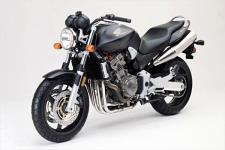
Back then, 893 cubic centimeters were all Honda needed to turn the sportbike world on its ear with a class-leading power-to-weight ratio. Today, for this new-old crowd, the mill has grown to 919 cubes and pumps out even more torque, though the peak power numbers are, not surprisingly, lopped off in favor of more around-town drivability. But then again, that’s the focus of this bike whereas its predecessor’s goal was much more narrow-focus.
But just because the new 919 isn’t a race bike doesn’t mean it has to have as much torque or weigh as much as a milk truck. Its claimed dry weight makes it the lightest naked bike in the open class. And even though the motor doesn’t have class leading peak power, Honda is more than happy with the output, insisting that the gobs of torque and lithe feel will entice more buyers than peaky dyno charts.
Under the Hood
Starting up top, the motor is a dual overhead cam design with shims residing under buckets. The valves are splayed at a 32 degree included angle and, making sure the machine is easy to live with, the valve maintenance interval is a lengthy 16,000 miles. The cylinders have a 71 mm bore and 58 mm stroke and feature a 10:1 compression ratio.
Of course, Honda’s latest programmed fuel injection system is what delivers the fuel which flows at 50 psi through four injectors in each 36 mm throttle body. Each injector nozzle has four laser-drilled holes for a “highly atomized air/fuel charge for maximum combustion, efficiency and power,” says Honda.
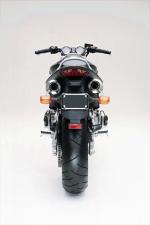
“Keeping things cool in the motor are a liquid-cooled oil cooler and a lightweight aluminum radiator.”
The exhaust system is of the four-into-two-into-one-into-two type and features “expanding-diameter” tubing heading up into the two “center-up” mufflers. Keeping the riders legs safe and cool are stainless steel muffler covers. Keeping things cool in the motor are a liquid-cooled oil cooler and a lightweight aluminum radiator. There is also a lightweight one-piece alternator that puts out more juice than the unit found on the old 893 cc motor, and it helps to power the multi-reflector, twin filament headlight.
As with the motor, the 919’s frame is designed primarily for street use, taking a route that’s decidedly less aggressive than the original CBR900RR, and even employs some of Honda’s “tuned flex” theories. The frame is a square tube, mono-backbone steel unit that utilizes the engine as a stressed member. A single box-section downtube extends to the front engine mounts that incorporate a cross-member to link the frame to the engine’s solid front mounts. At the back of the bike, an aluminum swingarm features a large one-piece cast pivot block and extruded triple-box-section spars.
Suspension on the 919 features 43 mm forks that work through 4.7 inches of travel. At the rear of the bike, a single shock provides 5.0 inches of travel and features a remote reservoir. Unfortunately neither end possesses adjustment capability for either compression or rebound damping. The only changes a rider can make without tearing things apart is an increase or decrease in the shock’s preload. Seven positions are available to suit each rider’s appetite for destruction.
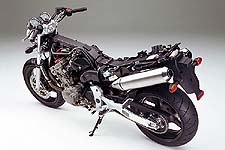
Braking duties are handled by a pair of 296 mm discs up front while a single 240 mm rotor resides out back. Four piston calipers clamp down on the front rotors while a single piston caliper pinches the spinning disc out back. These discs are mounted to hollow aluminum alloy three-spoke wheels.
Since the bike’s target audience is decidedly more inclined to spend his time in urban areas instead of rural outcroppings, searching for that perfect line through that perfect corner, the 919’s instruments also put the emphasis on rider comfort and relevant information. The cluster features a black-face analog speedometer, tachometer and water temperature indicators with white numerals. There is also a digital odometer and tripmeter as well as indicator lights for turn signals, neutral, high beam and the usual low fuel and oil pressure lights. Strangely for a bike designed to be so “urban” in its design, a clock is conspicuously absent.
Under the Helmet
Poring over the specifications handed out by Honda at the technical briefing on the 919, we were prepared to be less than impressed when their latest bike hit the road. For starters, the dyno chart they showed us looked like the old CBR900’s graph with the top two thousand rpm lopped off. “There’s your ‘re-tuned for mid-range,'” we thought. Then there was the overwhelming lack of suspension adjustments and a steel frame that had us thinking “flexi-flyer.”
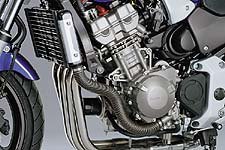
Its a good thing, then, that we know when our first instincts are wrong, and that we’re not afraid to change our opinion when faced with new information that runs strongly counter to our mis-guided preconceptions. The first of which, weight, had to be discarded immediately. Just sitting on the bike at a standstill, it’s amazing how physically small the bike feels. Photos suggest something along the lines of the old CB1000’s stature, though that bike feels a good 20-something percent larger in comparison.
The ergos on the machine are – not to be redundant – classic standard. The seat is all you need to keep your soft butt from the hard plastic pan below, but little more. Look elsewhere for Gold Wing comfort, though the 919’s seat is much better appointed than most sportbikes.
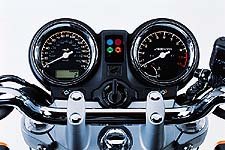
The bars are pretty standard as well, made of steel and swept back in a way that places your arms in a natural if slightly dorky position, elbows just down to the side and slightly in front of you. Of course, youll find your feet comfortably below you and not too far back or in front of your knees.
This places you in a slightly forward-canted position that’s comfortable for around-town tiddling or the bit of backroad frolicking.
“Even as low as 2,000 rpm, the motor never complained when the throttle was whacked open.”
Because the riding position is so upright, its easy to chalk up the 919’s light feel to ergonomic appointments – at least at first. But when rolling through the twisties, initiating turn-in and then tightening a line with little more than a thought and a light push on the bar in the direction you need to go, the bike follows your command, you immediately think back to the spec charts and Honda’s “lightest in class” claims. No doubt the bike’s 25 degrees of rake and 57.5 inch wheelbase play a part here, as does the low center of gravity.
Mid-corner, however, is where things start to go a bit awry. If there’s a bump or a series of bumps on a corner’s entrance, the stock suspension settings allow the bike’s back end to move up and down at will. This makes holding a line difficult at best as the bouncing back end tends to do awkward things to the front’s feel. To rectify the situation, we tried increasing the rear shock’s preload (the only option available) by notching the ramped adjust up from its second to fourth position of seven available.
Immediately the back end was stiffer, but it was not any more controlled over the bumps. In fact, the stiffer setting only heightened our awareness of the bike’s need for an increase in rebound damping. The ride became choppy and there was only a little increase in control. We ended up backing the adjuster down a notch (to the third of seven) and just learning to live with things, focusing our attention on other, more positive areas of the 919’s performance.
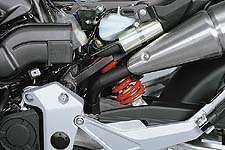
The motor, for instance, is a wonderful unit that had us developing a serious case of the scrunchies, wherein we were constantly straining our face muscles on corner exits. Any gear, any speed, and the 919 cc motor pulls without a hiccup. Even as low as 2,000 rpm, the motor never complained when the throttle was whacked open. The same compliments can be paid to the motor’s performance in the upper revs, though you’ll seldom need to venture there. We found ourselves playing between the 5,000 and 9,000 rev-range most of the time, never needing anything more, or less.
We did shift through the gearbox on occasion though, if only to sample the excellent six-speed transmission’s smooth gear changes and well-chosen ratios. This also allowed us to hear the burbles emanating from the dual under-seat mufflers exiting just aft of our own aft section. Neither loud nor totally quiet, but totally enjoyable. Running through the gears generated yet another excuse to enjoy the application of the 919’s excellent Nissin front binders. Excellent initial bite that was followed up by equally wonderful modulation and feel inspire confidence heading into every bend.
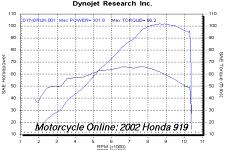
On the open highway, the motor’s smooth nature shines through once again, all but eliminating any in-line buzz you were expecting. The only thing that holds this bike back from being a serious all-round mileage eater is a fairing in the style of Yamaha’s FZ-1 that produces just enough of blast deflection to keep you from doing your best impersonation of a human parachute.
In all, Honda’s done quite a job with this new 919 of theirs. It’s already on the fast track to becoming a staff favorite. So much love has already flowed its way that we’ve asked Honda for the bike as a long-term tester as we surmise this great machine is only a set of clip-ons and a decent shock away from being an excellent bike.
Specifications:
Suggested Retail Price: $7,999 Engine Type: 919cc liquid-cooled DOHC inline four-cylinder Bore and Stroke: 71.0mm x 58.0mm Compression Ratio: 10.8:1 Valve Train: DOHC; four valves per cylinder Carburetion: PGM-FI with manual enricher circuit Ignition: Computer-controlled digital with three-dimensional mapping Transmission: Six-speed Final Drive: #530 O-ring-sealed chain Front Suspension: 43mm cartridge fork; 4.7-inch travel Rear Suspension: Single shock with seven-position spring-preload adjustability; 5.0-inch travel Front Brakes: Dual full-floating 296mm discs with four-piston calipers Rear Brake: Single 240mm disc with single-piston caliper Front Tire: 120/70ZR-17 radial Rear Tire: 180/55ZR-17 radial Wheelbase: 57.5 inches Rake (Caster Angle): 25.0 degrees Trail: 98.0mm (3.9 inches) Seat Height: 31.5 inches Dry Weight: 427.0 pounds Fuel Capacity: 5.0 gallons Color: Asphalt
The post Church of MO: 2002 Honda 919 First Ride appeared first on Motorcycle.com.
Copyright
© Motorcycle.com

